Bipan Chandra Summary: Indian States & Society in 18th Century | History for UPSC CSE PDF Download
Indian States and Society in the 18th Century
Rise of Independent Powers
- Following the decline of the Mughal Empire, various independent and semi-independent powers emerged in India during the 18th century.
- States such as Bengal, Avadh, Hyderabad, Mysore, and the Maratha Kingdom challenged British attempts at supremacy.
- Some states originated from the assertion of autonomy by Mughal provincial governors, while others stemmed from rebellion against Mughal authority.
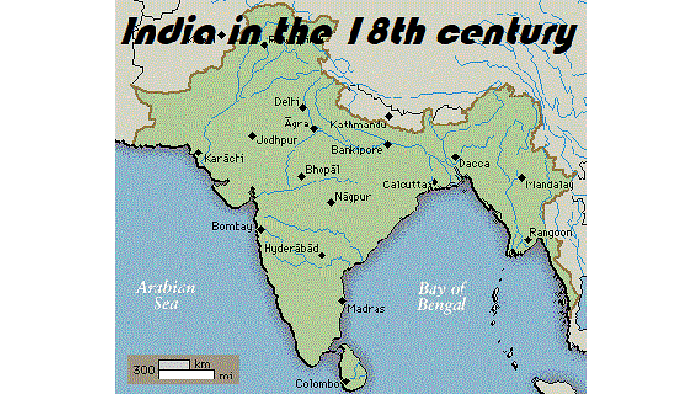 India in the 18th Century
India in the 18th Century
Administrative and Economic Development
- Rulers of these states established law and order, and functional economic and administrative systems.
- They managed to control lower local officials and petty chiefs who vied for control over peasant produce.
- Politics in these states were generally non-communal or secular, with rulers motivated by economic and political concerns rather than religious biases.
- Religious discrimination in public appointments, civil, or military matters was rare.
Economic Challenges
- Despite administrative stability, none of these states effectively tackled economic crises.
- Conflict persisted among zamindars and jagirdars over declining agricultural incomes, leading to worsening conditions for the peasantry.
- While internal trade was maintained and efforts were made to promote foreign trade, there was little modernization of industrial and commercial structures.
Hyderabad
- Founded by Nizam-ul-Mulk Asif Jah in 1724, Hyderabad emerged as a significant power in the Deccan.
- Nizam-ul-Mulk consolidated his authority by suppressing opposition and organizing efficient administration.
- Despite not openly declaring independence from Delhi, Nizam-ul-Mulk acted as an independent ruler in practice.
- He pursued a tolerant policy towards Hindus and established an orderly administration, keeping powerful Marathas at bay.
- Efforts were made to reform the revenue system, but Hyderabad faced disruptive forces after Nizam-ul-Mulk's death in 1748.
The Carnatic
- Initially a subah of the Mughal Deccan, the Carnatic came under the authority of the Nizam of Hyderabad.
- The Deputy Governor, known as the Nawab of Carnatic, effectively became independent and hereditary in office.
- Internal struggles for Nawabship led to deterioration in the Carnatic's affairs, opening the door for European trading companies to intervene in Indian politics.
Bengal in the 18th Century
Independence under Exceptional Leadership
- Murshid Quli Khan and Alivardi Khan took advantage of the weakening central authority to establish virtually independent rule in Bengal.
- Murshid Quli Khan, despite being appointed Governor in 1717, effectively ruled Bengal since 1700 as its Dewan.
- He maintained peace and stability in Bengal, reducing internal and external threats and minimizing zamindar uprisings.
Administrative and Economic Reforms
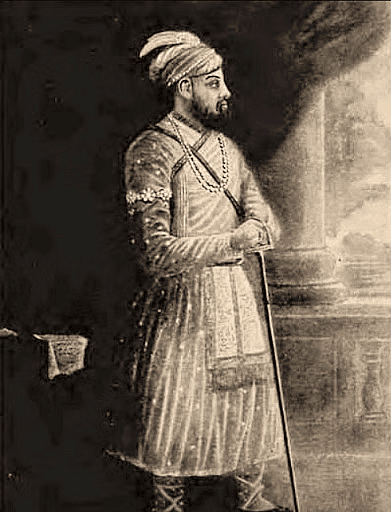 Murshid Quli Khan
Murshid Quli Khan
- Murshid Quli Khan implemented administrative reforms, including reorganizing finances, transferring jagir lands into khalsa lands, and introducing revenue-farming.
- He granted agricultural loans to alleviate distress among cultivators and increase government resources, but this led to economic pressure on peasants.
- Despite demanding standard revenue and forbidding illegal cesses, collection from zamindars and peasants was often harsh.
Social Policies
- Murshid Quli Khan and succeeding Nawabs provided equal employment opportunities to Hindus and Muslims, filling civil and military posts with Bengalis, predominantly Hindus.
- Preference was given to local zamindars and money-lenders in revenue farming, laying the groundwork for a new landed aristocracy.
Trade and Foreign Relations
- All three Nawabs recognized the benefits of trade and promoted it by providing safety measures for merchants and preventing abuses in customs administration.
- They maintained strict control over foreign trading companies, ensuring compliance with laws and customs duties.
- Alivardi Khan restricted the fortification of English and French factories, but the Nawabs were short-sighted regarding the aggressive colonialism of the English East India Company.
Failure to Address English Threat
- The Bengal Nawabs underestimated the threat posed by the English East India Company, failing to firmly address its increasing use of military force.
- They lacked awareness of the Company's expansionist colonialism, which eventually proved costly for the state.
The ignorance and lack of awareness about the global context led to miscalculations regarding the Company's intentions and capabilities, ultimately contributing to Bengal's subjugation by the British.
Continuation: Indian States and Society in the 18th Century
Weakness in Military and Governance
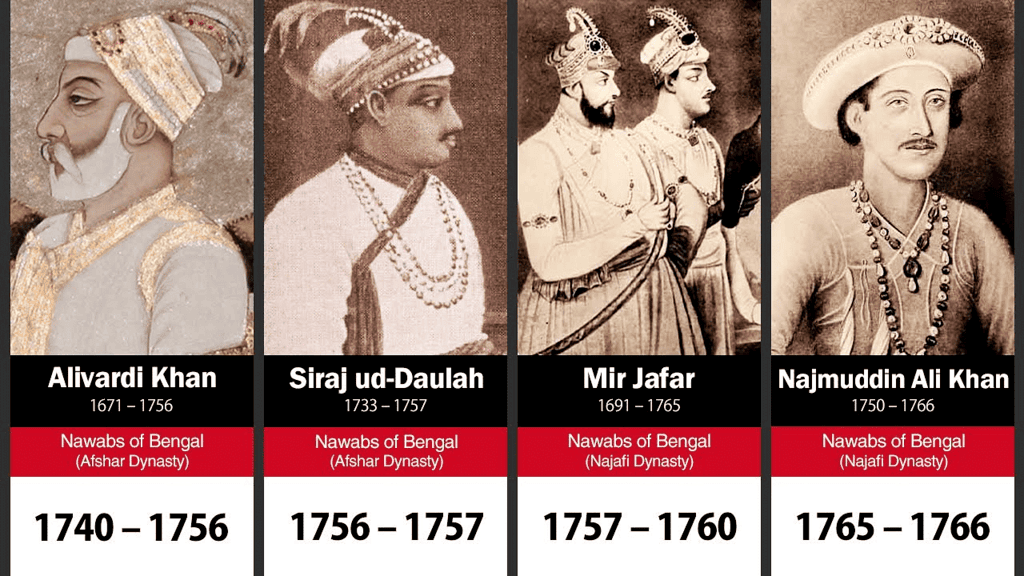 Nawabs of Bengal
Nawabs of Bengal
- The Nawabs of Bengal neglected to build a strong army, resulting in vulnerability to external threats and eventual defeat by the English East India Company.
- For example, Murshid Quli Khan's army consisted of only 2000 cavalry and 4000 infantry, insufficient to counter threats effectively.
- Alivardi Khan faced repeated invasions by the Marathas and ultimately had to cede a large part of Orissa to them.
- Weak military contributed to the victory of the English East India Company in 1756-57 against Siraj-ud-Daulah, Alivardi's successor.
- Additionally, corruption among officials, including judicial authorities, undermined governance and allowed foreign companies to exploit weaknesses in regulations and policies.
Avadh: Establishment and Administration
- Saadat Khan Burhan-ul-Mulk founded the autonomous kingdom of Avadh after his appointment as Governor in 1722.
- He effectively dealt with rebellious zamindars, suppressing lawlessness and disciplining them to increase government resources.
- Although defeated zamindars were often retained in their estates, their rebellious tendencies persisted, weakening the Nawab's authority.
- Saadat Khan implemented a fresh revenue settlement in 1723, improving conditions for peasants and maintaining impartiality in governance between Hindus and Muslims.
Safdar Jang's Rule and Cultural Development
- After Saadat Khan, his nephew Safdar Jang continued the administration, ensuring a prolonged period of peace and economic prosperity.
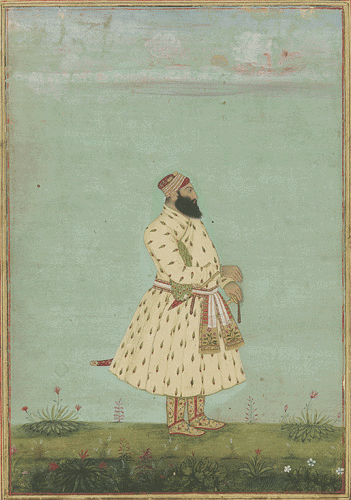 Safdar Jung
Safdar Jung
- He suppressed rebellions, formed alliances with Marathas, and secured military support against internal and external threats.
- Safdar Jang maintained an equitable system of justice and impartiality in employment, promoting Hindu-Muslim harmony.
- Under his rule, a distinct Lucknow culture flourished, rivaling Delhi in arts, literature, and handicrafts.
- Personal morality was upheld by Safdar Jang and his predecessors, despite political complexities and intrigues.
Mysore under Haidar Ali and Tipu Sultan
Preservation of Independence
- Mysore, after the decline of the Vijayanagar Empire, maintained its independence, albeit precariously.
- In the early 18th century, ministers Nanjaraj and Devraj seized power, reducing the king to a mere puppet.
- Haidar Ali, born in 1721, rose from humble beginnings to become a significant figure in Mysore's history.
Rise to Power
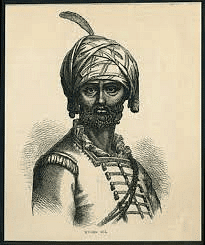 Haidar Ali
Haidar Ali
- Haidar Ali recognized the benefits of western military training and modernized the Mysore army, establishing a modern arsenal in Dindigul with French assistance.
- In 1761, he overthrew Nanjaraj and extended his authority over Mysore, conquering territories and establishing full control over rebellious zamindars.
- Despite being illiterate, he proved to be an efficient administrator, making Mysore one of the leading Indian powers.
Conflicts and Military Exploits
- Haidar Ali engaged in wars with the Marathas, the Nizam, and the British, repeatedly defeating British forces and even reaching the walls of Madras in 1769.
- He died in 1782 during the second Anglo-Mysore War, succeeded by his son Tipu Sultan.
- Tipu Sultan was an innovator, introducing changes such as a new calendar, coinage system, and scales of weights and measures.
Administration and Reforms
- Tipu Sultan attempted to increase state income by reducing the granting of jagirs and hereditary possessions of the poligars.
- Although his land revenue was high, he checked the collection of illegal cesses and granted liberal remissions.
- He modernized the Mysore army, armed with muskets and bayonets, and made efforts to build a modern navy.
Recognition of Threats
- Tipu Sultan recognized the threat posed by the rising English power in India and stood as a formidable opponent against British expansionism.
- Despite his recklessness in action and unstable nature, he displayed foresight as a statesman, acknowledging the dangers posed by British imperialism.
Tipu Sultan's efforts to modernize Mysore and resist British encroachment mark him as a significant figure in Indian history, standing against colonial aggression and striving to preserve the independence of his kingdom.
Economic and Cultural Developments in Mysore, Kerala, and Other Regions
Economic Prosperity under Haidar Ali and Tipu Sultan
- Despite some economic backwardness, Mysore flourished economically under the rule of Haidar Ali and Tipu Sultan.
- The peasantry in Mysore was found to be more prosperous than those in British-occupied territories, surprising British officials.
- Governor-General John Shore acknowledged the protection and rewards provided to the peasantry in Mysore.
- Tipu Sultan recognized the importance of economic strength, making attempts to modernize trade and industry by importing foreign experts and supporting various industries.
- He sent embassies to Iran and Pegu to develop foreign trade and even attempted to establish a trading company.
Tolerance and Religious Views of Tipu Sultan
- Contrary to some British historians' portrayal, Tipu Sultan was not intolerant.
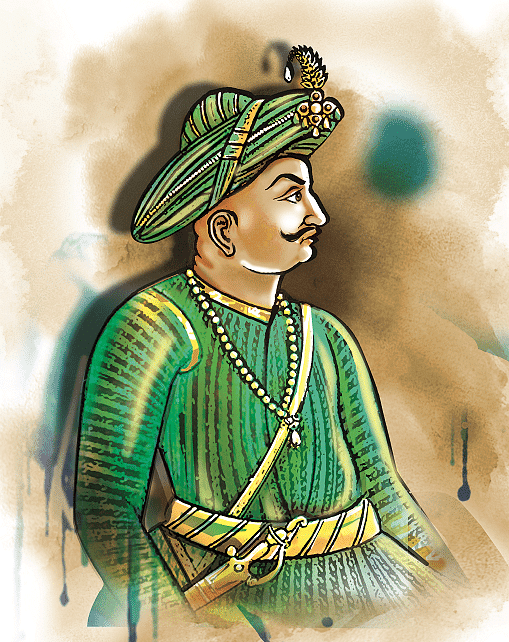 Tipu Sultan
Tipu Sultan
- Although he held orthodox religious views, he displayed tolerance and enlightenment toward other religions.
- Tipu Sultan financially supported the construction of temples, including the goddess Sarda temple in Shringeri, after it was damaged by Maratha horsemen in 1791.
Travancore's Rise under Martanda Varma
- At the beginning of the 18th century, Kerala was divided among feudal chiefs and rajas.
- Travancore, under King Martanda Varma, rose to prominence after 1729.
- Martanda Varma subdued feudal territories, conquered Quilon and Elayadam, and defeated the Dutch, ending their political power in Kerala.
- He organized a strong army on western lines, constructed a modern arsenal, and expanded Travancore's boundaries northwards.
Cultural Revival and Patronage in Kerala
- In the 18th century, there was a remarkable revival in Malayalam literature, partly due to the patronage of rajas and chiefs in Kerala.
- Trivandrum, the capital of Travancore, became a famous center of Sanskrit scholarship, attracting scholars and fostering cultural exchange.
- Rama Varma, successor of Martanda Varma, was a multifaceted individual, excelling in poetry, music, and scholarship, and demonstrating interest in European affairs.
The economic prosperity, cultural revival, and tolerant governance in Mysore, Travancore, and Kerala during the 18th century exemplify the diverse and dynamic nature of South Indian states and societies during this period.
Regional Powers and Developments around Delhi
Rajput States
- Rajput states capitalized on the weakening Mughal authority to assert their independence and expand influence within the empire.
- Rulers of prominent Rajput states like Amber and Marwar were appointed governors of key Mughal provinces during the reigns of Farrukh Siyar and Muhammad Shah.
- Despite the expansion, internal divisions persisted among Rajputana states, leading to constant conflicts and civil strife.
- Raja Sawai Jai Singh of Amber emerged as a notable figure, known for his contributions to science, city planning, and social reforms.
Jats
- The Jats, primarily agriculturists, inhabited the regions surrounding Delhi, Agra, and Mathura.
- Driven by oppression from Mughal officials, Jat peasants rebelled under the leadership of zamindars in 1669 and 1688.
- Initially a peasant uprising, the Jat revolt evolved into a predatory movement, disrupting the area and engaging in court intrigues at Delhi.
- Churaman and Badan Singh established the Jat state of Bharatpur, reaching its peak under Suraj Mal, who expanded its authority over a vast territory.
Bangash Pathans and Rohelas
- Muhammad Khan Bangash established control over the Farmkhabad territory during Farrukh Siyar and Muhammad Shah's reigns.
- Ali Muhammad Khan founded Rohilkhand, a principality in the foothills of the Himalayas, clashing frequently with neighboring states.
The Sikhs
- Founded by Guru Nanak in the 15th century, Sikhism spread among the Jat peasantry and lower castes in Punjab.
- Guru Gobind Singh transformed Sikhs into a political and military force, leading them in constant wars against Mughal armies and hill rajas.
- After Guru Gobind Singh's death, Banda Singh Bahadur continued the struggle against the Mughals but was eventually captured and executed in 1715.
- The invasions of Nadir Shah and Ahmad Shah Abdali disrupted Punjab administration, allowing Sikhs to rise again and gain wealth and power through plundering.
- Between 1765 and 1800, the Sikhs brought Punjab and Jammu under their control, organizing into confederacies known as misls.
The regions surrounding Delhi witnessed the rise of various powers, including the Rajput states, Jats, Bangash Pathans, Rohelas, and Sikhs, each contributing to the complex political landscape of 18th-century India.
The Punjab under Ranjit Singh
Rise to Power
- Ranjit Singh, chief of the Sukerchakia Misl, emerged as a prominent figure at the end of the 18th century.
- Known for his military prowess, administrative efficiency, and diplomatic skills, he captured key cities like Lahore and Amritsar.
- Ranjit Singh gradually consolidated power over the Sikh chiefs west of the Sutlej, establishing his own kingdom in the Punjab.
Administration and Military
- He maintained the Mughal system of land revenue calculation, levying taxes based on 50% of the gross produce.
- Ranjit Singh built a powerful and disciplined army along European lines, recruiting soldiers from diverse backgrounds.
- Modern foundries were established in Lahore to manufacture cannons, and Muslim gunners were employed to operate them.
Government and Tolerance
- Ranjit Singh appointed capable ministers regardless of their religious affiliations, fostering a tolerant and inclusive administration.
- His court included prominent figures like Fakir Azizuddin and Dewan Dina Nath, demonstrating religious diversity in governance.
- While a devout Sikh himself, Ranjit Singh showed respect for other religions, exemplified by his actions towards Muslim mendicants.
Relations with the British
- In 1809, the British forbade Ranjit Singh from crossing the Sutlej River and protected Sikh states east of the river.
- Recognizing the British strength, Ranjit Singh opted for diplomatic realism to preserve his kingdom temporarily.
- However, his death left his successors embroiled in internal power struggles, paving the way for British conquest.
The Rise and Fall of the Maratha Power
Background and Civil War
- The Maratha Kingdom emerged as the most powerful successor state to the Mughal Empire, possessing the strength to fill the political void.
- Shahu, grandson of Shivaji, engaged in a civil war with his aunt Tara Bai, leading to a power struggle among Maratha sardars.
- Maratha sardars, seeking to increase their power, sided with either Shahu or Tara Bai, bargaining for influence in the process.
Transformation under Balaji Vishwanath
- Out of the conflict, a new system of Maratha government emerged under the leadership of Balaji Vishwanath, the Peshwa of King Shahu.
- This marked the beginning of the Peshwa domination in Maratha history, transforming the state into an empire.
The Punjab under Ranjit Singh witnessed a period of consolidation and military strength, while the Maratha power, despite its initial promise, faced internal strife and transformation under the leadership of Balaji Vishwanath.
Balaji Vishwanath and the Rise of the Maratha Empire
Early Career and Ascension
- Balaji Vishwanath, a Brahmin, began his career as a petty revenue official and gradually climbed the ranks through loyal service to Shahu.
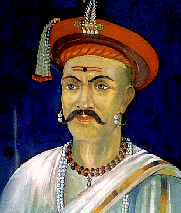 Balaji Vishwanath
Balaji Vishwanath
- He was appointed Peshwa in 1713, becoming the chief minister and consolidating Shahu's control over Maratha sardars in Maharashtra.
- Balaji Vishwanath concentrated power in his office, eclipsing other ministers and sardars, effectively making the Peshwa the functional head of the Maratha Empire.
Expansion and Diplomacy
- He leveraged internal conflicts among Mughal officials to expand Maratha power, negotiating agreements like the one with Zulfiqar Khan for the collection of chauth and sardeshmukhi.
- An agreement with the Saiyid brothers restored territories to Shahu, who agreed to place cavalry troops at the Emperor's service and pay an annual tribute.
- Balaji Vishwanath accompanied Saiyid Hussain Ali Khan to Delhi in 1719, witnessing the weakness of the Mughal Empire and harboring ambitions of expansion in the North.
Administrative Innovations
- For efficient revenue collection, he assigned separate areas to Maratha sardars, allowing them to retain a portion of the collection for their expenses.
- This system of assignment strengthened the Peshwa's personal power through patronage, attracting ambitious sardars to his side.
- However, it also contributed to the decentralization of power as sardars established control in distant Mughal lands with their private armies.
Baji Rao I and Maratha Expansion
Ascension and Military Campaigns
- Balaji Vishwanath's son, Baji Rao I, succeeded him as Peshwa at the age of 20, demonstrating boldness as a military commander and astuteness as a statesman.
- Under Baji Rao's leadership, the Marathas waged numerous campaigns against the Mughal Empire, aiming to secure the right to collect chauth and expand their territories.
- By 1740, the Marathas had gained control over Malwa, Gujarat, and parts of Bundelkhand, with prominent Maratha families like Gaekwad, Holkar, Sindhia, and Bhonsle coming into prominence.
Confrontation with Nizam-ul-Mulk and Other Campaigns
- Baji Rao focused on containing Nizam-ul-Mulk's power in the Deccan, engaging in battles where the Nizam was ultimately compelled to grant the Marathas control over Deccan provinces.
- He also launched campaigns against the Sidis of Janjira and the Portuguese, expelling the former from the mainland and capturing territories like Salsette and Bassein from the latter.
Legacy and Empire Building
- Baji Rao's reign marked a transformation of the Maratha state from a kingdom into an empire expanding in various directions.
- Maratha armies overran vast regions of India, consolidating control over Malwa, Gujarat, Bundelkhand, and even exerting influence over Bengal and the South.
- Despite his successes, Baji Rao's empire-building efforts lacked attention to administration, leading to challenges in governance and revenue collection.
Balaji Baji Rao (Nana Saheb), succeeding his father, continued the expansion of the Maratha Empire, further extending its reach across India and solidifying Maratha control in various regions.
The Third Battle of Panipat and its Aftermath
Preparation and Alliances
- Ahmad Shah Abdali formed an alliance with Najib-ud-daulah of Rohilkhand and Shuja-ud-daulah of Avadh, both of whom had grievances against the Marathas.
- The Marathas dispatched a powerful army to the north, led by Sadashiv Rao Bhau, to confront Abdali's forces at Panipat.
- Attempts to find allies among northern powers failed due to Maratha interference in their internal affairs and ambitious political agenda.
The Battle of Panipat
- The two forces clashed at Panipat on 14 January 1761, resulting in a complete rout of the Maratha army.
- Key Maratha commanders like Vishwas Rao and Sadashiv Rao Bhau perished along with numerous soldiers.
- The Maratha retreat was marked by pursuit and further plundering by local groups like the Jats, Ahirs, and Gujars.
Consequences
- The defeat at Panipat dealt a severe blow to the Marathas, resulting in the loss of their elite forces and a significant decline in political prestige.
- While the Afghans emerged victorious, they failed to consolidate their hold over the Punjab.
- The battle did not determine who would rule India but rather opened the door for the rise of British power.
Madhav Rao and the Restoration of Maratha Power
Ascension and Achievements
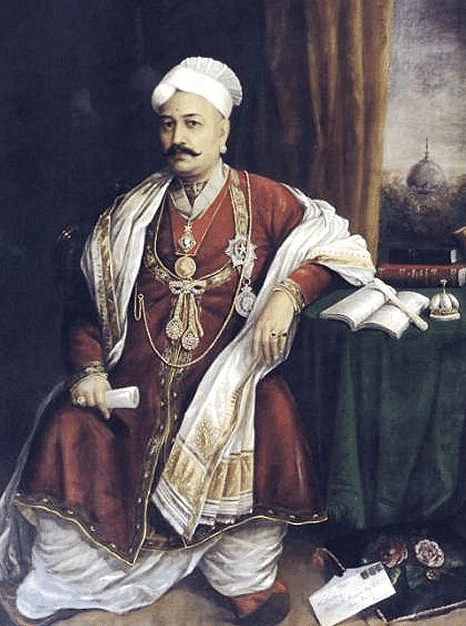 Madhav Rao
Madhav Rao
- Madhav Rao became Peshwa in 1761 at the age of 17 and quickly demonstrated talent as both a soldier and a statesman.
- Within 11 years, he restored Maratha fortunes by defeating the Nizam, compelling tribute from Haidar Ali of Mysore, and reasserting control over North India by defeating the Rohelas and subjugating Rajput states and Jat chiefs.
- In 1771, he brought Emperor Shah Alam back to Delhi, solidifying Maratha influence in the North.
Challenges and Succession Issues
- Despite Madhav Rao's successes, his untimely death in 1772 plunged the Maratha Empire into confusion.
- A power struggle ensued between Raghu- nath Rao and Narayan Rao, leading to Narayan Rao's assassination in 1773.
- Raghu- nath Rao's alliance with the British sparked the First Anglo-Maratha War.
Decline and Fragmentation of Maratha Power
Intrigue and Factionalism
- Intrigue and power struggles persisted in Poona between supporters of Sawai Madhav Rao and Raghunath Rao.
- Meanwhile, major Maratha sardars like Gaekwad, Bhonsle, Holkar, and Sindhia began carving out semi-independent states in the North, diminishing their allegiance to the Peshwas.
- These sardars established their own administrations and armies, often aligning with opposing factions in Poona and even conspiring against the Maratha Empire.
Mahadji Sindhia's Influence
- Mahadji Sindhia, aided by French officers, built a formidable army and gained control over Emperor Shah Alam in 1784.
- He secured the appointment of the Peshwa as the Emperor's Deputy (Nawab-i-Munaib), effectively acting on behalf of the Peshwa.
- Sindhia's energies were often focused on intrigues against Nana Phadnis and engaging in conflicts with rivals like Holkar of Indore.
- His death in 1794 marked the end of an era, along with the passing of Nana Phadnis in 1800, both significant figures in Maratha history.
Succession and British Intervention
- Sawai Madhav Rao's death in 1795 left the incompetent Baji Rao II, son of Raghunath Rao, as Peshwa.
- The British, recognizing the threat posed by Maratha power, undertook a strategy of diplomatic manipulation to divide and conquer.
- The Second Maratha War (1803-1805) and the Third Maratha War (1816-1819) saw the British overpowering the Marathas in separate battles.
- While some Maratha states were allowed to remain as subsidiaries, the Peshwa dynasty was eliminated, marking the end of Maratha political dominance.
Analysis of Maratha Empire and Its Downfall
Comparison with Mughal Empire
- Both the Maratha and Mughal Empires shared a similar social and administrative structure, with decentralized power and revenue systems.
- Maratha chiefs mirrored the behavior of later Mughal nobles, prioritizing personal gain over centralized authority.
Economic and Social Conditions
- 18th-century India faced economic stagnation and social inequality, exacerbated by oppressive taxation and the greed of nobles and officials.
- Despite the existence of extreme poverty alongside wealth, the quality of life for the masses was relatively better than under later British rule.
Trade and Commerce
- Indian trade, both internal and external, flourished under the Mughals despite disruptions caused by warfare and lawlessness.
- India's self-sufficiency in agriculture and handicrafts allowed for a steady export of goods, particularly textiles, to various regions.
- However, constant warfare and the proliferation of customs duties imposed by regional rulers hampered trade to some extent.
Impact of Maratha Rule
- The Marathas failed to modernize their state or promote economic development, relying heavily on traditional revenue extraction methods.
- Their dominion was characterized by force rather than loyalty, similar to the Mughals, and lacked the capacity to withstand the rising British power.
Impact on Trade and Industries
Destruction of Prosperous Cities
- Numerous prosperous cities, hubs of thriving industries, faced destruction due to invasions and conflicts:
- Nadir Shah plundered Delhi, Ahmad Shah Abdali sacked Lahore, Delhi, and Mathura, and Maratha chiefs ravaged Surat and other cities of Gujarat and the Deccan.
- Artisans catering to feudal lords and courts suffered as their patrons' fortunes declined, and the decline in trade further impacted them.
Resilience of Indian Industries
- Despite setbacks, India remained a hub of extensive manufacturing, with artisans renowned worldwide for their skills.
- Key industries included cotton and silk textiles, sugar, jute, dye-stuffs, mineral and metallic products, arms, metal wares, and oils.
- Various cities across India served as centers for different industries, showcasing the diversity and richness of India's industrial landscape.
Shipbuilding Industry
- Shipbuilding flourished in regions like Maharashtra, Andhra, and Bengal, with Indian artisans possessing remarkable skills.
- Indian-made ships were in high demand by European trading companies, showcasing the quality and expertise of Indian craftsmen.
India's Significance in World Trade
- At the turn of the 18th century, India held a prominent position in world trade, with Peter the Great of Russia acknowledging its significance.
- India's control over commerce was seen as pivotal in influencing global trade dynamics.
Education Landscape
Traditional Education System
- Education in 18th century India was largely traditional and focused on literature, law, religion, philosophy, and logic.
- It lacked emphasis on modern subjects like physical and natural sciences, technology, and geography.
- Original thought was discouraged, and reliance was placed on ancient learning.
Centers of Higher Education
- Higher education centers were scattered throughout India, often funded by nawabs, rajas, and wealthy zamindars.
- For Hindus, higher education was centered around Sanskrit learning and was primarily accessible to Brahmins, while Persian education was popular among both Hindus and Muslims.
Elementary Education
- Elementary education was widespread, imparted through town and village schools for Hindus and maktabs run by Maulvis in mosques for Muslims.
- Subjects included reading, writing, and arithmetic, with higher castes primarily benefiting but some individuals from lower castes also receiving education.
Gender Disparity
- Girls were seldom given access to education, although exceptions existed among women from higher classes.
- Overall literacy rates were comparable to later periods under British rule, though primary education standards were deemed inadequate by modern standards.
- Teachers enjoyed high prestige in society, but the education system suffered from gender inequality.
Social Structure and Cultural Life
Diversity and Division
- Social life and culture in 18th-century India varied significantly across regions, religions, tribes, languages, and castes.
- Hindus and Muslims did not form homogeneous societies; instead, people were divided along various lines, leading to diverse social patterns.
Role of Caste
- Caste played a central role in Hindu social life, with rigid divisions determining social status and professions.
- Higher castes, particularly Brahmins, enjoyed social prestige and privileges, while lower castes faced discrimination and restrictions.
- Intercaste marriages were forbidden, and dining restrictions existed between different castes, enforced by caste councils and chiefs.
Division Among Muslims
- Muslims were also divided based on considerations of caste, race, tribe, and status, despite Islam's principle of social equality.
- Shia and Sunni nobles sometimes clashed due to religious differences, and various Muslim groups maintained distinctions.
- Converted Hindus often carried their caste into Islam, albeit less rigidly, and social stratification existed among Muslims akin to the caste system.
Family Structure
- Family structures were predominantly patriarchal, with senior male members holding authority and inheritance passing through the male line.
- In Kerala, matrilineal family systems were prevalent, contrary to the patriarchal norm elsewhere.
- Women's roles were primarily confined to motherhood and wifehood, although they received respect and protection, especially during war and anarchy.
Role of Women
- Women generally had limited individuality and were expected to adhere to traditional roles, but exceptions existed, such as Ahilya Bai who administered Indore successfully.
- While upper-class women were confined to domestic duties, peasant women often worked in fields, and poorer women supplemented family income through outside work.
- The practice of purdah, or seclusion, was common among higher-class women in the North but less prevalent in the South.
Marriage and Social Norms
- Marriages were arranged by family heads, with boys and girls not permitted to interact freely.
- Men were allowed multiple wives, although monogamy was the norm for most except the wealthy, while women were expected to marry only once.
- Early marriage customs prevailed, with some children married off as young as three or four years old.
Social Customs and Cultural Development
Customs and Social Evils
- Heavy expenses on marriages and dowry prevailed among the upper classes, with the latter being particularly widespread in Bengal and Rajputana.
- Sati, the practice of a Hindu widow self-immolating on her husband's funeral pyre, was prevalent mainly among the families of rajas, chiefs, and upper castes.
- Widows, especially from higher classes and castes, faced severe restrictions and were often subjected to a pitiable existence, unable to remarry.
- Efforts to promote widow remarriage, such as those by Raja Sawai Jai Singh of Amber and Maratha General Prashuram Bhau, met with limited success.
Cultural Trends
- India displayed signs of cultural stagnation during the 18th century, maintaining continuity with the past but lacking innovation.
- Traditional cultural activities were primarily funded by royal courts, rulers, and nobles, whose declining wealth led to neglect of cultural pursuits.
- Decline was particularly notable in arts dependent on royal patronage, such as Mughal architecture and painting, although new schools of painting emerged, such as the Kangra and Rajput schools.
- Music continued to flourish, with significant developments during the reign of Muhammad Shah.
- Literature in Indian languages became detached from contemporary life, retaining traditional themes and exhibiting pessimism reflective of prevailing despair.
- Urdu language and poetry experienced vigorous growth, becoming a prominent medium of social interaction among the upper classes in northern India.
Regional Literary Revivals
- In regions like Kerala, there was a revival of literature under the patronage of rulers, leading to significant literary achievements, such as the works of Kunchan Nambiar and the development of Kathakali.
- In Tamil Nadu, poets like Tayumanavar protested against abuses in temple rituals and the caste system.
- Assam saw literary development under the Ahom kings, while Gujarat witnessed the lyrical contributions of poets like Dayaram.
- In Punjab, Waris Shah composed the romantic epic "Heer Ranjha," and Sindhi literature flourished with poets like Shah Abdul Latif composing influential works.
Weakness in Science and Technology
- India lagged far behind the West in science and technology during the 18th century, despite historical contributions in mathematics and natural sciences.
- The Indian mind remained tied to tradition, and superstition was prevalent among both nobles and common people.
- Indians were largely ignorant of Western scientific, cultural, political, and economic achievements, with rulers showing little interest except in military advancements.
- This weakness in scientific advancement contributed significantly to India's eventual subjugation by more technologically advanced Western powers.
Morality and Social Harmony
Degeneration of Nobility
- The struggle for power and wealth, along with economic decline and cultural stagnation, had a detrimental effect on the morals of some Indians, particularly the nobility.
- Virtues like loyalty, gratitude, and honesty began to wane among the nobles, who often succumbed to vices and excessive luxury, including bribery.
- However, surprisingly, common people maintained a high level of personal integrity and morality despite the challenging circumstances.
- European observers like John Malcolm praised the virtue and qualities exhibited by a significant proportion of the Indian population, noting the absence of common vices like theft, drunkenness, and violence.
Religious and Communal Relations
- Despite incessant conflicts among nobles and chiefs, friendly relations between Hindus and Muslims were a healthy feature of 18th-century India.
- Politics were primarily secular, with little communal bitterness or religious intolerance observed.
- Mutual respect and tolerance prevailed among people of different religious affiliations, with Hindus and Muslims often sharing each other's joys and sorrows.
Cultural Synthesis
- Hindus and Muslims cooperated in various non-religious spheres such as social life and cultural affairs, contributing to the evolution of a composite Hindu-Muslim culture.
- Urdu language and literature provided a new meeting ground for cultural exchange between Hindus and Muslims.
- The influence of the Bhakti movement among Hindus and Sufism among Muslims continued to foster mutual respect and admiration.
- Religious festivals and processions were attended by members of both communities, showcasing the harmony and mutual participation in each other's traditions.
Factors Influencing Social Harmony
- Religious affiliation was not the primary determinant of cultural and social life; instead, regional and class distinctions played a more significant role.
- Upper-class Hindus and Muslims exhibited greater cultural convergence than upper-class and lower-class individuals within the same religious group.
- Regional differences also contributed to varying patterns of social and cultural life, with village dwellers often having distinct practices compared to urban residents.
|
110 videos|652 docs|168 tests
|
FAQs on Bipan Chandra Summary: Indian States & Society in 18th Century - History for UPSC CSE
| 1. What were the major economic and cultural developments in Mysore, Kerala, and other regions during the 18th century? |  |
| 2. How did regional powers around Delhi influence the political landscape in the 18th century? |  |
| 3. What factors contributed to the rise and fall of the Maratha power in the 18th century? |  |
| 4. How did Ranjit Singh establish and consolidate his rule in the Punjab during the 18th century? |  |
| 5. What were the key achievements of Bengal in the 18th century under the Mughal rule? |  |

















